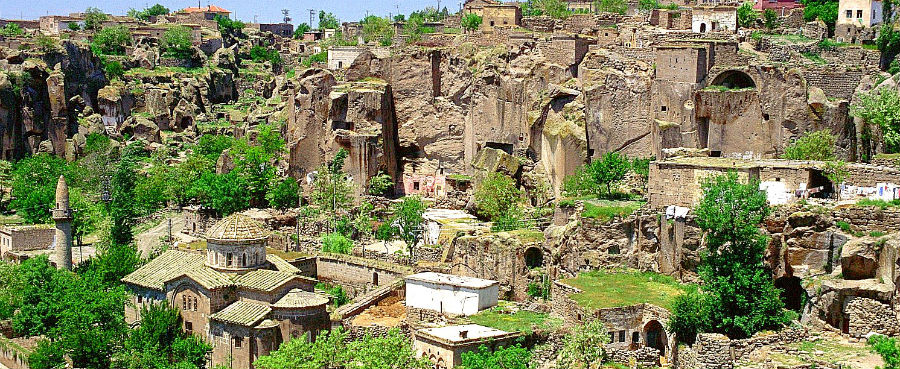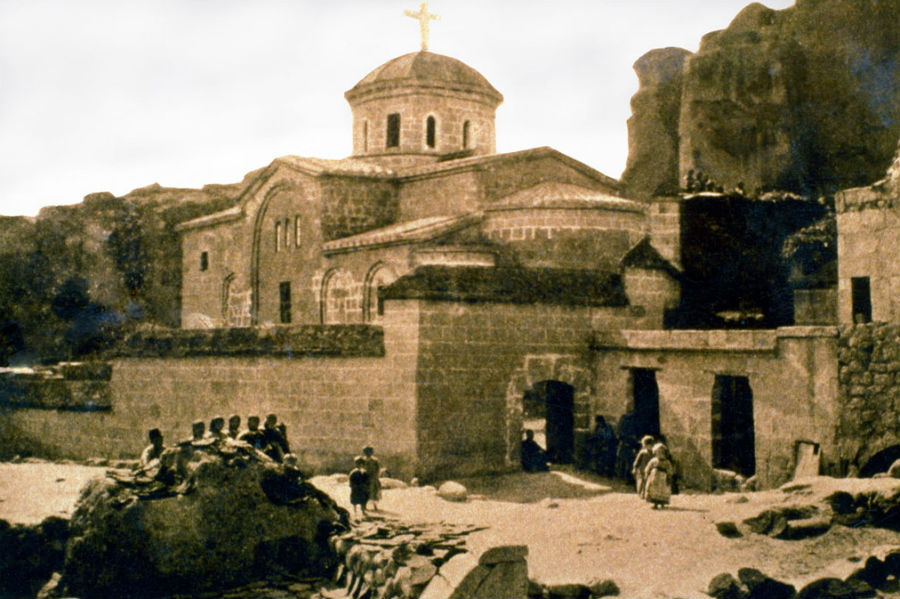Guzelyurt, formerly Gelveri, is a town and district of Aksaray Province in the Central Anatolia region of Turkey, at a distance of 45 km from the city of Aksaray. According to 2000 census, population of the district is 16,836 of which 3,775 live in the town of Guzelyurt. The district covers an area of 322 km2 and the average elevation is 1,485 m.
This is an area of great natural beauty and historical importance, part of the ancient region of Cappadocia, near the much-visited Ihlara Valley.
Cappadocia has an important place in the history of Christianity and Gregory of Nazianzus lived in the area. A historically large Greek population existed in the area until the 1924 population exchange (see Cappadocian Greeks), when they were replaced with the Turks from Thessaloniki and Kavala.
Guzelyurt is known for having three underground cities and over 50 churches carved into the rocky volcanic landscape including:
- Ihlara Valley
- Monastery Valley, “Manastır Vadisi”
- Fairy Chimneys, “Peri Bacaları”
- Antique Greek houses
- Ahmatlı Church
- St. Anargiros Church, “Sivişli Kilise”
- Koç Church
- Cathedral of Selime
- The rock monastery of Selime, one of the largest religious buildings in Cappadocia.
- Red Church, “Kızıl Kilise” – a 5th or 6th century church in the village of Sivrihisar
- Analipsis Church, “Yüksek Kilise” (High Church) on the hill of Analipsis. Stone age relics have been found nearby.
- St. Gregorius Church, “Kilise Cami” – another rock-hewn church, in use today as a mosque
- St. Spyridon Church, “Kızıl Kilise” – another red church in the vicinity of Güzelyurt.
Other places of interest include…
- The tomb of Selime Sultan in the village of Selime.
- Linseed House, “Bezirhane” in the village of Belisırma.
- Ziga thermal springs, “Ziga kaplıcaları” is located in the village of Yaprakhisar very close to Ihlara Valley.
- A recently discovered underground city is situated in Gaziemir village of Güzelyurt.
There is a town on the edge of Cappadocia called Guzelyurt is one of favorite discoveries !
Güzelyurt means “beautiful land.” It’s best known in Turkey as the town where historic enemies Greeks, Turks, Kurds, and Bulgarians live in peace. The town is a harmony of cultures, history, architecture, and religions. Walk down streets that residents from 3,000 years ago might recognize, past homes carved into the rocks, enjoying friendly greetings of merhaba (hello). Scowling sheepdogs, caged behind 10-foot-high troglodyte rockeries, give the scene just enough tension.
Walk to a viewpoint at the far side of town (above the Sivisli church), toward the snowy slopes of the Fuji-like volcano that rules the horizon. Before you is a lush and living gorge. The cliff rising from the gorge is stacked with building styles: Upon the 1,600-year-old church sit troglodyte caves, Selcuk arches, and Ottoman facades. And on the horizon gleams the tin dome of the 20th-century mosque, with its twin minarets giving you a constant visual call to prayer. The honey that holds this architectural baklava together is the people.
Put your camera away, close your mouth, and sit silently in the sounds of 1000 B.C. Children play, birds chirp, roosters crow, shepherds chase goats, and mothers cackle. (Ignore that distant motorbike.)
Below you, sleeping in the greens and wet browns of this tidepool of simple living, is the church of St. Gregorius. Built in 385, it’s thought by Gregorian fans to be the birthplace of church music, specifically the Gregorian chant. Its single minaret indicates that it’s preserved as a mosque today in a valley where people call god Allah.
Güzelyurt, in central Turkey, is 35 miles from Nevsehir and a short bus ride from Aksaray. It’s near the Peristrema Valley, famous for its seven-mile hike through a lush valley of poplar groves, eagles, vultures, and early Christian churches.
Guzelyurt, Cappadocia,



Aya Gregorios Theologos Church is is beautiful especially walls of pictorial relief is very beautiful.
Southeast of Aksaray the peaceful small town of Güzelyurt stands on the edge of a gorge full of dramatic rock formations. For those who relish authenticity, this is one of the parts of Cappadocia where traditional life lives on in its most unaltered form.
Visitors sometimes base themselves here while they explore the spectacular Ihlara Gorge, then move speedily on again. That’s a pity since there’s much more to a place that was, until 1924 and the Greco-Turkish population exchange, the predominantly Greek settlement of Gelveri. And with the peaceful air of a place overlooked by the outside world, it could hardly be further from the madding crowds that increasingly besiege the better-known towns of Cappadocia.
Güzelyurt (“Beautiful Home”) is most famous as the home of St. Gregory of Nazianzus (St. Gregory the Theologian, c.329-389), one of the so-called Cappadocian Fathers whose writings and teachings helped establish some of the fundamental tenets of Christianity. A close friend of St. Basil of Caesarea (modern Kayseri), Gregory spent much of his life battling what were then seen as heresies, but now look like so much theological nit-picking. He was briefly bishop of Constantinople (İstanbul) and it’s there, in the Greek Patriarchate in Fener, that some of his remains have eventually come to rest after Crusading shenanigans that saw them carried off to Rome in 1204.
Not surprisingly, the most significant monument in Güzelyurt is what was once the Church of St Gregory and is now the Büyük Kilise Cami (Big Church Mosque) right in the heart of the old village. A 19th-century rebuild and a 21st-century restoration make it hard to appreciate that what now looks like a relatively new building actually stands on the site of an original that dated back to the fourth century and which was erected right beside an ayazma, or sacred spring, still accessible down a steep flight of steps. The church is thought to have been commissioned by the Byzantine Emperor Theodosius, and there are those who see in its small dome the model for the great Hagia Sophia (Aya Sofya) in İstanbul. The recent restoration saw a 19th-century wooden iconostasis donated by Tsar Nicholas I moved from the apse to provide a frame for the mihrab, but the pulpit still remains in place, high up on one of the columns. In the grounds a brick minaret built above the gateway has taken the place of the 19th-century clock tower.
Today the mosque’s congregation is slowly fading away as people move into houses in the upper, newer part of town around the modern Ulu Cami. But Gelveri was one of those Cappadocian settlements that received a significant boost at the end of the 19th century as locals who realized that they would never grow rich if they stayed put took themselves to İstanbul where they were soon making enough money to send some back to pay for schools and churches in their home towns. Across the road and up a steep flight of steps is the Sivişli Kilise (Church of the Panagia), which looks like a traditional Cappadocian rock-cut church complete with frescoed dome and apse. It may come as a surprise, then, to discover that it dates back only to this renaissance period at the end of the 19th century.
Not far from the Büyük Kilise Cami you’ll find the entrance to one of Güzelyurt’s two underground cities, pieces in a complex network of hiding places that can be found all over Cappadocia and are believed to date back in part to Hittite times. This one shows clear signs of later reuse with tandır ovens cut into the ground for cooking, but its most famous feature is its squat toilet, isolated along a narrow corridor and the only such convenience so far identified in the underground cities.
It’s well worth taking time to wander around the pretty back streets of Güzelyurt, where you’ll find many fine carved gateways, some still bearing inscriptions in Greek. Here, too, you’ll come across several impressive neighborhood fountains where people would come to collect water in the days before everyone had plumbed-in supplies. More unexpectedly, you’ll also come across a small rock-cut mosque complete with mihrab and mimber that may have started life as a church. It’s the only such example known in Cappadocia.
Signs direct visitors to the 4.5-kilometer-long Monastery Valley, an Ihlara in miniature although without the stream that is such a plus in summer. Cut into the sides of the rocky gorge are yet more small churches that belonged to the original settlement of Karvali (Karballa). They may not boast the fine frescoes of Ihlara but unless you come at the weekend there’s a fair chance you’ll have them to yourself.
While in Güzelyurt it’s worth diverting six kilometers south through the village of Sivirhisar in search of the Kızıl Kilise (Red Church). Standing in splendid isolation in a field, this free-standing sixth-century church is a rarity in Cappadocia (there’s one other, later model, the Çanlı Kilise, south of Aksaray), and was visited in 1907 by that tireless British explorer Gertrude Bell, copies of whose photos adorn the walls of the Otel Karballa. Archeologists speculate that this was the site of Arianzus, the village where St. Gregory was born. Across the field a small mound surmounted by a wild pear tree turned out to cover a tiny fourth-century basilica; it’s possible that St. Gregory’s remains were originally buried in one or other of these two churches. The tiny basilica stood right beside the pilgrimage route that headed south to Antioch (Antakya) and then to Jerusalem; its route is still clearly visible today. Restoration of the Kızıl Kilise is scheduled to start this month.
On the other side of Güzelyurt a somewhat top-heavy stone structure perches on top of a rock overlooking the man-made Gelveri Gölü. This turns out to be a monastic complex made up of the 19th-century Yüksek Kilise (High Church), otherwise known as the Analipsis Kilise (Ascension Church), and a block containing monastic cells and a small refectory with superb views out towards Hasan Dağı (Mount Hasan, 3,258 meters). Cut into the rock face, a flight of steps beside a huge cistern provided easy access. A Neolithic settlement has been identified in fields around the bottom of the rock; slithers of obsidian still littering the ground testify to past tool-making endeavors.
In 1924 the Greeks of Gelveri moved to Nea Karvali outside the Thracian town of Kavala. Every July some of their descendants return to Güzelyurt to remember their ancestry in a whirlwind of festivities alongside the descendants of Turks from Kozan and Kastoria who arrived to take their place.
Until recently Güzelyurt was too far off the beaten track to boast much in the way of accommodation. The single exception was the Otel Karballa, housed inside what was, until 1924, a Greek seminary and where guests can eat their meals in an arch-vaulted dining room; as a sop to softer tourist sensibilities a swimming pool has been installed to the rear. Now though the locals seem to be wising up to the possibilities of tourism, and there are several pensions dotted around the village, most boasting great views from their terraces. Meanwhile, the older men with the longest memories pass their days in the timeless tea gardens of the main square where, beneath their feet, yet another underground city now houses an atmospheric bar.
Guzelyurt boasts a mountain plateau climate and is famous for its recreation spots that offer different colours in each season.
The old name of this town was Nazianzus (Guzelyurt). It was an important center for early Christianity. St. Gregory, one of the most famous of the early Cappadocian patriarchs was bishop there in the 4th century.